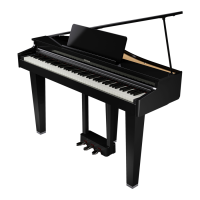15
° Troubleshooting
Problem Items to check Cause/Action Page
Problems with the piano’s sound
No sound
Is the volume turned down? Raise the volume.
p. 7
Could headphones or an adaptor plug be inserted in the Phones
jack?
If headphones or an adaptor plug are inserted in the headphones jack,
sound is not output from the speakers.
p. 6
If you want sound to be produced from headphones, is the device connected correctly? –
Pitch of the keyboard or song is
incorrect
Could you have made Transpose settings? Disable transpose in the Transpose settings.
p. 3
Is the Master Tune setting appropriate?
When shipped from the factory, the reference pitch is set to “442.0 Hz”.
Check the Master Tuning settings.
p. 3
Sounds are heard twice
(doubled) when the keyboard
is played
Could “Dual Play” be specied, so that two tones are layered?
Hold down the [
] (settings) button and press the A0 key to exit Dual
Play mode.
p. 8
Could the piano be connected to an external sequencer?
If you don’t want the piano to be played from another sound module, set
your music production software’s “soft thru” setting to “O”.
–
Reverberation remains even if
you defeat the Ambience eect
This simulates the depth and ambience of the acoustic piano’s sound, and is not a malfunction. Even if the Ambience eect is o, the acoustic
piano’s own resonance remains.
–
The sound of the higher notes
suddenly changes from a certain
key
On an acoustic piano, the higher notes of the piano (from the highest key down around 1½ octaves) fully sustain after you play them even if
the damper pedal is not pressed. The sound is also dierent.
In this way, this piano faithfully recreates the sound of an acoustic piano. Also, the key range that is unaected by the damper pedal changes
depending on the transpose settings.
–
When you press a key, the sound
of a note you didn’t press is also
faintly heard
In some cases, a note you play might cause a dierent note (whose frequency is an integer multiple of the rst note) to resonate, producing the
sensation that the sound has changed; this is not a malfunction.
–
High-pitched ringing is heard
If you can hear this in headphones:
Some piano tones that feature a brilliant and consistent sound include many high-frequency components, which may include some
reverberations that could sound metallic. This is a faithful recreation of the original characteristics of a piano, and is not a malfunction.
This kind of reverberation tends to be more audible when the more ambience eect is applied, so you might try reducing the ambience eect
to help mitigate this issue.
p. 2
If you can’t hear this through headphones:
There may be another issue causing this, such as the sound resonating with the piano unit. Please contact your dealer or a Roland customer
service center.
–
Low notes sound wrong,
or are buzzy
Could the volume be set to maximum?
If the volume is at the maximum, the sound might be distorted depending
on how you play the piano. If this occurs, lower the volume.
p. 7
If you can hear this in headphones:
It may be that the piano has malfunctioned. Please contact your dealer or a Roland customer service center.
–
If you can’t hear this through headphones:
It may be that the objects near the piano are resonating because of the high volume of sound coming from the speakers. You can take the
following measures to minimize resonances.
• Keep the volume down.
• Locate the speakers 10–15 cm (4–6 inch) away from walls or other surfaces.
• Move away from the objects that are resonating.
–
The sound is heard dierently
depending on the tone settings
When using “Dual Play” which layers two tones, the sound you hear may dier depending on the specic combination. For some combinations,
the eect is not applied to the left-hand tone. This is not a malfunction.
–

